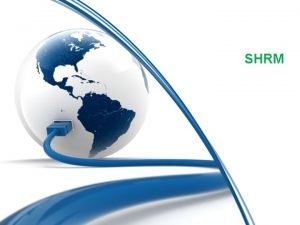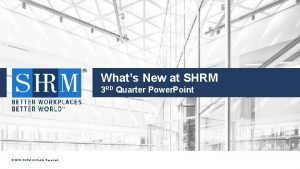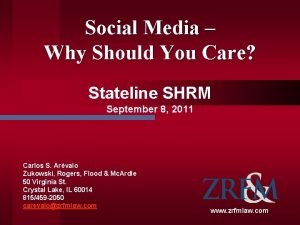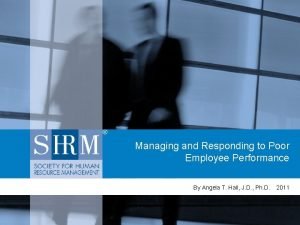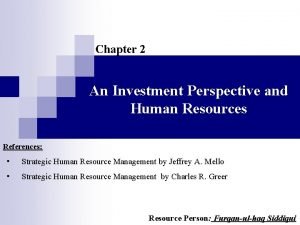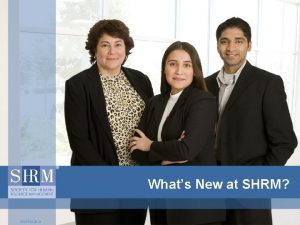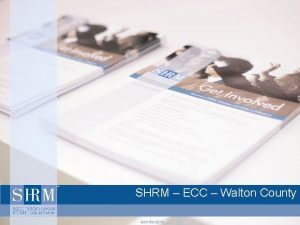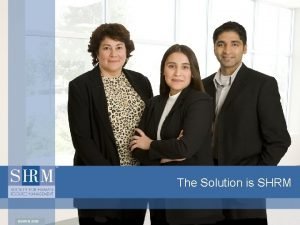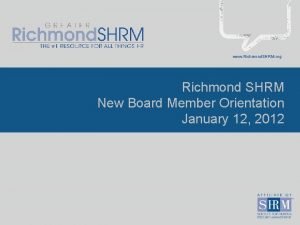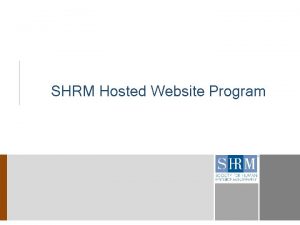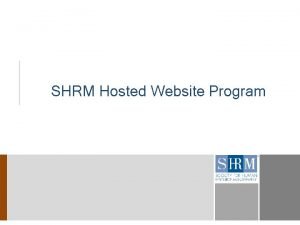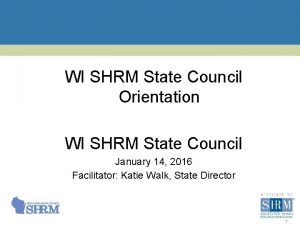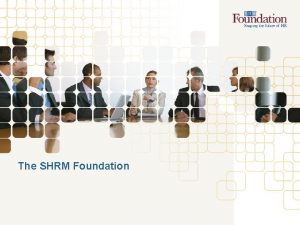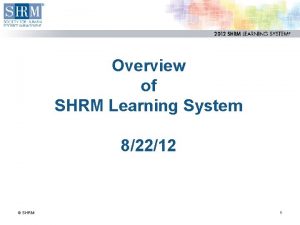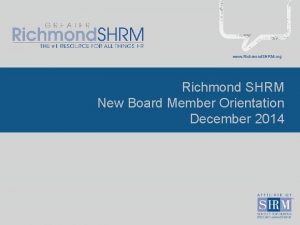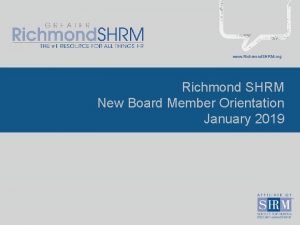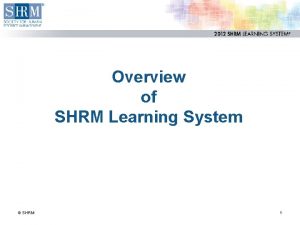SHRM EVOLUTION OF SHRM PERSONAL MANAGEMENT Part of














- Slides: 14

SHRM

EVOLUTION OF SHRM PERSONAL MANAGEMENT Part of mechanistic organization Bureaucratic High centralization High formalization Low flexibility HRM ( 70 s) Part of organic organization Crosshierarchical and cross functional teams Decentralized Low formalization Flexible SHRM (80 S) Convergence between HRM & Business Strategy Pro-active HRM Concerned with organizational effectiveness & performance

DIFFERENCE BETWEEN SHRM & TRADITIONAL HRM DIMENSIONS TRADITIONAL HRM SHRM Responsibility for HR programmes Staff personnel in the HR department Line managers; all managers responsible for people are HR managers Focus of activities Employee relations – ensuring employee motivation and productivity; compliance with laws Partnerships with internal (employees) & external ( customers, stakeholders, public interest group) groups. Role of HR Reactive & transactional Pro-active and transformational, change leader Initiative for change Slow, piecemeal and fragmented, not integrated with larger issues Fast, flexible and systematic, change initiatives implemented in concert with other HR systems

DIFFERENCE BETWEEN SHRM & TRADITIONAL HRM DIMENSIONS TRADITIONAL HRM SHRM Time horizon Short term Consider various time frames as necessary ( short term, medium term and long term) Control Bureaucratic control through rules, procedures and policies Organic control through flexibility, as few restrictions on employee behavior as possible Job design Focus on scientific management Broad job design, flexibility, principles – division of labor, teams and groups and cross independence, and specialization training Important investments Capital, products, technology and finance People and their knowledge, skills and abilities Accountability Cost centre Investment centre

Link Between HR Strategy & Business Strategy • Central to the concept of SHRM is the idea of strategic fit. • In order to ensure that HR strategies facilitate the achievement of business strategies, a strategic integration between the two is necessary. • A key factor that influences the linkage between business strategy and HR strategy is the organization’s quest to attain competitive advantage. • An organization may pursue several different strategies to achieve its goal.

§ Three types of business strategies that may be adopted by an organization are: § Cost leadership § Differentiation § Focus

Business strategy Characteristics Examples Cost Leadership §The firm increases its efficiency , cuts costs so that the products or services may be priced lower than the industry average §Assumes that a small change in price will significantly affect customer demand §Assumes that customers show greater price sensitivity than brand loyalty Retailers such as Wall Mart, Lulu Center etc Differentiation • The firm distinguishes its products/services from its competitors or at least attempts to make consumers perceive that there are differences • The firm charges premium for its products/services because it offers its customers something that is unique, extra-ordinary or innovative Samsung, i. Phone Focus §The firm recognizes that different segments of the Bentley Cars market have different needs and attempts to satisfy one particular group §The firm can charge premium

Business strategy HR Strategy Cost Leadership §Suitable for repetitive and predictable behavior §Concerned with short term focus §Result-oriented Utilization HR Strategy § HR Strategy focused on short term performance measures §Efficiency is the norm, job assignments are specialized, explicit job descriptions §Hierarchical pay, few incentives §Narrow career paths, limited training §Limited employment security §Limited participation Differentiation §Long term focus §Creative job behavior §Modern concern for quality and quantity Facilitation HR Strategy § Broad career paths §Extensive Training §Equal and fair pay, many incentives for creativity §Long term performance measures §External recruitment and hiring of people who bring in new ideas §High employee participation §Some employment security Focus §High concern for quality §Moderate concern for quantity §Long/medium term focus Accumulation HR Strategy § Equal and fair pay with many incentives §Hiring employees belonging to the target market §Broad career paths with extensive training §High employee participation §Some employee security

ENVIRONMENTAL TRENDS AFFECTING HRM Trends in Business Environment Globalization of business Merger & Acquisition Downsizing Changing Nature of Employment Relationship HRM FUNCTION Workforce diversity Ageing population & workforce Women in workforce Changing family structure Global workforce Contingent workforce & workforce flexibility Demographic, Societal & Workforce Trends Changing Nature of Work Industry & occupational shifts Technological changes Outsourcing Flexible work arrangements

FUNCTIONS OF HRM MANAGERIAL FUNCTIONS Planning Organizing OPERATING FUNCTIONS Directing Controlling

OPERATING FUNCTIONS Organizational Design Job Analysis Employment HRD Compensation Management Human Relations HRP Performance Appraisal Job Evaluation Induction Recruitment Training Wage & Salary Admn Morale Selection Mgmt Fringe Benefits Development Induction Career Planning & Development Placement Organizational Change & Development Job Satisfaction Communication Grievance & Disciplinary Procedures QWL & QC

OBJECTIVES OF HRM • Create and utilize an able and motivated workforce, to accomplish the basic organizational goals. • To establish and maintain sound organizational structure and desirable working relationships among all the members of the organization. • To secure the integration of individual and groups within the organization by co-ordination of the individual and group goals with those of the organization. • To create facilities and opportunities for individual or group development so as to match it with the growth of the organization • To attain an effective utilization of human resources in the achievement of organizational goals

OBJECTIVES OF HRM • To identify and satisfy individual and group need by providing adequate and equitable wages, incentives, employee benefits and social security and measures for challenging work, prestige , recognition, security, status etc. • To maintain high employee morale and sound human relations by sustaining and improving the various conditions and facilities • To strengthen and appreciate the human assets continuously by providing training and development programs • To consider and contribute to the minimization of socio-economic evils such as unemployment, underemployment, inequalities in the distribution of income and wealth and to improve the welfare of the society by providing employment opportunities to women and disadvantaged sections of the society.

OBJECTIVES OF HRM • To provide an opportunity for expression and voice in management • To provide fair, acceptable and efficient leadership • To provide facilities and conditions of work and creation of favorable atmosphere for maintaining stability of employment.
 Evolution of shrm notes
Evolution of shrm notes Shrm performance management
Shrm performance management Part part whole addition
Part part whole addition Part to part ratio definition
Part to part ratio definition Brainpop ratios
Brainpop ratios What is a technical description?
What is a technical description? The parts
The parts The part of a shadow surrounding the darkest part
The part of a shadow surrounding the darkest part Two way anova minitab 17
Two way anova minitab 17 Shrm broker finder
Shrm broker finder Shrm social media policy
Shrm social media policy Calhr progressive discipline
Calhr progressive discipline Shrm regrettable turnover
Shrm regrettable turnover Investment perspective of hrm
Investment perspective of hrm Shrm competency model
Shrm competency model
